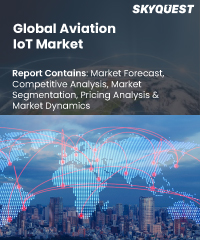
Report ID: SQMIG45A2168

Report ID:
SQMIG45A2168 |
Region:
Global |
Published Date: February, 2024
Pages:
157
|
Tables:
64 |
Figures:
75
Aviation IoT Market size was valued at USD 5.60 Billion in 2021 and is poised to grow from USD 6.90 Billion in 2022 to USD 36.89 Billion by 2030, at a CAGR of 23.3 % during the forecast period (2023-2030).
The global Aviation IoT Market refers to the market for Internet of Things (IoT) solutions and technologies within the aviation industry. It encompasses the application of IoT devices, connectivity, and data analytics to enhance various aspects of aviation, including aircraft operations, maintenance, passenger services, and overall safety. The purpose of this market is to revolutionize the aviation sector by leveraging IoT capabilities to optimize flight operations, reduce operational costs, improve aircraft performance, and offer a seamless passenger experience. One of the key driving factors behind the growth of the Aviation IoT Market is the increasing demand for improved efficiency and safety in the aviation industry. IoT solutions enable real-time data monitoring, predictive maintenance, and proactive decision-making, ensuring that airlines can operate with higher precision and reliability. the growing focus on digitalization and the need for data-driven insights have propelled the adoption of IoT technologies in aviation. Despite the promising prospects, the market also faces some restraining factors. One major challenge is the complexity and cost of integrating IoT solutions into existing aviation infrastructures. Retrofitting older aircraft with IoT capabilities may be costly and time-consuming, leading to slower adoption rates. Moreover, concerns regarding data security and privacy issues also pose challenges, as aviation stakeholders need to ensure that sensitive data is protected from potential cyber threats. Amidst the challenges, the Aviation IoT Market also presents significant opportunities. The integration of IoT technologies can lead to substantial cost savings through optimized maintenance schedules, fuel consumption, and operational efficiency. Airlines can harness IoT-enabled data insights to make informed decisions, minimize downtime, and reduce environmental impact. Moreover, the growing demand for connected in-flight services and personalized passenger experiences opens doors for innovative applications of IoT in aviation. the Global Aviation IoT Market is at the forefront of transforming the aviation industry by leveraging IoT technologies for enhanced efficiency, safety, and passenger satisfaction. While challenges such as integration costs and security concerns persist, the market's potential benefits, including cost savings, improved operations, and enhanced services, offer lucrative opportunities for stakeholders in the aviation sector to embrace and capitalize on IoT innovations.
US Aviation IoT Market is poised to grow at a sustainable CAGR for the next forecast year.
Our industry expert will work with you to provide you with customized data in a short amount of time.
REQUEST FREE CUSTOMIZATIONWant to customize this report? This report can be personalized according to your needs. Our analysts and industry experts will work directly with you to understand your requirements and provide you with customized data in a short amount of time. We offer $1000 worth of FREE customization at the time of purchase.

Report ID: SQMIG45A2168